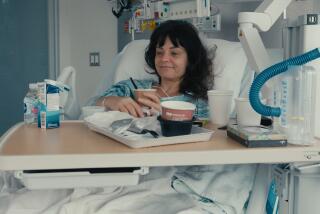‘Kidney Girl’ Is Remembered for Her Achievements : Medicine: Marianne Levine raised public awareness of treatment of kidney disease with groundbreaking transplant in late 1960s.
- Share via
To thousands of people in the United States and Europe, she was the “Kidney Girl.” At her funeral Saturday, a quarter-century after her groundbreaking transplant that helped change the course of medicine, Marianne Levine was remembered for the simple, kind things she did during her surprisingly long life.
Levine, formerly Marianne Baratta, died of heart failure Monday at age 41, outside the spotlight that shone on her in 1968, when family, friends and schoolmates from the Granada Hills area raised more than $40,000 for her kidney transplant and use of an early dialysis machine.
Back then, the transplant technique was so new, and dialysis was so rarely used for children, that the door-to-door fund-raiser snowballed. European newspapers ran the story of the 16-year-old California Kidney Girl who could not afford the life-saving treatment.
Several thousand people attended a walkathon in the San Fernando Valley on “Marianne Baratta Day,” proclaimed by Mayor Sam Yorty. Gov. Ronald Reagan sent a check for $250 and his trademark jar of jellybeans, and gifts and letters poured in from other states and countries.
“The post office was incredible,” recalled Gordon Meighan, who helped organize the campaign. “We were getting letters addressed to ‘The Kidney Girl, California,’ that would come right to my house.”
After months on a dialysis machine, the Alemany High School student received a kidney from a security guard shot to death.
Her struggle was chronicled step by step in the local press. “Milestone for Marianne--Kidney Transplant Girl Wins Diploma at Alemany” read one headline. “Kidney Graft Patient Home as Yule Gift,” read another.
“I’ve got friends that I haven’t even met yet,” she told a reporter at the time. “Why, this could turn out to be the most wonderful year of my life.”
For most people, Marianne’s story stopped there. She lived the five healthiest years of her life after the surgery, married a high school sweetheart and got a job at a bank in Van Nuys.
But the kidney failed four years and nine months after the transplant, and Levine spent the next 20 years in and out of hospitals for twice-weekly dialysis treatments. She had a second kidney transplant, but her body rejected the organ right away. She chose not to try again.
Eventually, the young couple separated, and Levine moved in with a sister, and later with her mother, Joan Baratta, in Granada Hills.
“She never had a good day,” her mother said. “But she never asked ‘Why me?’ She always thought of other people’s problems first, and she said many times that she was glad it was her and not somebody else.”
Levine taught her nieces and nephews how to read. Later, without telling her family, she “adopted” a Bolivian child through a relief agency. But Levine spent her last few years mostly bedridden, in pain, her mother said. Even so, her death from heart failure came as a surprise to the family.
“You always think they’re going to come home with you, after so many trips to the hospital,” Joan Baratta said. “The last thing I see is two brown eyes looking at me with two big tears in them. She couldn’t talk because she was hooked up to all those machines. And that was her last conscious moment.”
A funeral Mass was held at St. John Baptist de la Salle Catholic Church in Granada Hills, the Baratta family’s church that started the fund to pay for her treatment.
Experts say Levine’s contribution to medicine went beyond raising public awareness of the possibilities of kidney transplants and dialysis, and helped lay the foundation for medical services that are now taken for granted, such as Medicare and organ donor cards.
“Marianne’s case was pivotal in highlighting the need for the state to pay for this type of care,” said Dr. Richard Fine, her physician at the time and now chairman of the Department of Pediatrics at the State University of New York at Stonybrook. “It was also a tremendous boom because it identified the need for cadaver organs, and helped get us going in the whole arena of organ sharing.”
Although dialysis and transplant patients are usually told they will lead relatively normal lives these days, the expectation for Levine and the handful of other young patients who received such treatment in the late 1960s was not so positive.
Dr. John De Palma, one of the pioneers of dialysis, said: “If you had told me back then that Marianne Baratta was going to live another 25 years, I would not have really believed it.”






